Raising Ducks: A Comprehensive Guide
Whether you’re charmed by their amiable waddling, interested in their sustainable contributions to pest control, or attracted to the prospect of farm-fresh eggs, raising ducks can be an enriching experience that offers plentiful rewards! However, just like embarking on any new journey, becoming a duck keeper requires a solid understanding of the responsibilities involved, along with knowledge of the birds’ needs and habits.
This comprehensive guide to raising them is designed to give you all the information you need to begin your venture into raising happy and healthy ducks! From choosing the right breed, understanding their dietary requirements, how to care for ducks and setting up a safe and comfortable living environment, we will explore each facet of duck care in detail.
Selecting Your Ducks
Choosing the right breed of duck is the first step. Some breeds are better suited for meat production, like the Pekin or Muscovy. While others, such as Indian Runner or Khaki Campbell, are prolific egg layers. If you’re interested in ornamental breeds, you should try considering the Mandarin or Wood Duck! Do research on various domestic duck breeds and choose one that suits your climate, space, and personal goals.
You can buy your ducks as hatchlings baby chicks (ducklings) from various sources including local farms, hatcheries, and online retailers. But do be sure that you’re purchasing duck chicks from a reputable source to guarantee healthy, disease-free birds, to maintain some happy ducks!
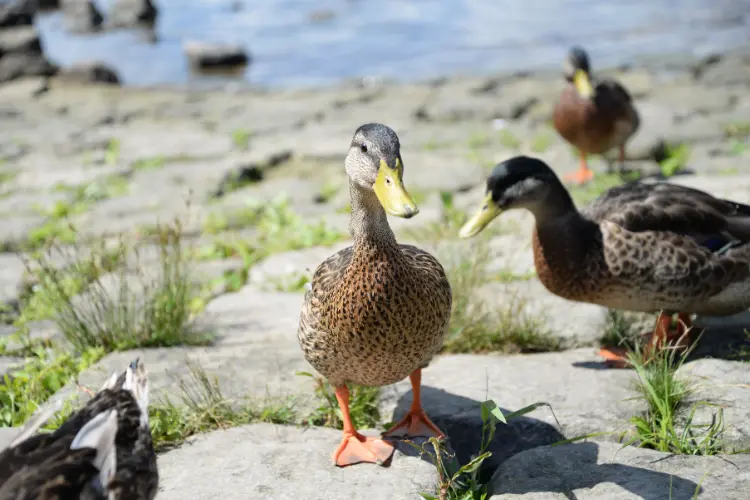
Housing and Space Requirements
Creating a suitable housing environment for your ducks is a critical aspect of their care and well-being. Ducks need a safe and comfortable place to rest, sleep, and take shelter from inclement weather or potential predators.
The type of housing you provide should be predator-proof and weather-resistant to protect chicken eggs and duck eggs from threats such as foxes, raccoons, and harsh weather conditions.
The basic structure of a duck house can vary based on your specific needs and available resources, but a common design is a wooden shed or coop with a door for the ducks to enter and exit. Inside the shelter, you should provide bedding made from straw or wood shavings for the ducks to rest on. The duck house must remain dry and well-ventilated.
Ducks produce a significant amount of moisture when they breathe, and without proper ventilation, this can lead to damp conditions, promoting bacterial and fungal growth and potentially leading to respiratory problems.
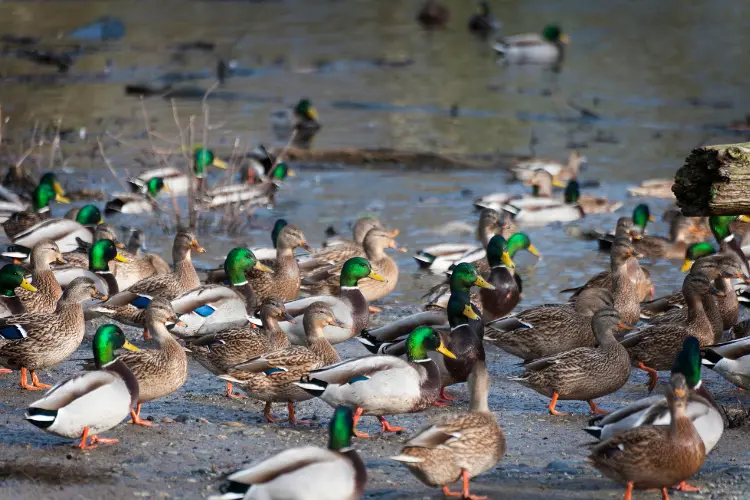
Regarding space requirements, plan for at least 2-4 square feet per duck inside the duck house. This allows each duck enough room to move around comfortably without feeling overcrowded, which can lead to stress and aggression.
The outdoor space requirement is even larger. Ducks need room to roam, forage, and express their natural behaviors, so an outdoor run should ideally offer 10-20 square feet per duck. Secure the outdoor duck run with a sturdy fence to keep out predators.
Lastly, ducks love water. If you can provide them with a water source, such as a pond or a kiddie pool for paddling and bathing, it would significantly enhance their living environment.
It’s crucial, though, to maintain the cleanliness of the water source to prevent any health problems.
Feeding Ducks: A Detailed Guide
Raising ducks is a rewarding endeavor, whether you’re doing it for egg production, meat, pest control, or simply as pets. However how many ducks, one crucial factor that significantly influences their health, growth, and productivity is their diet. Let’s explore the diets of these gorgeous creatures to provide you with a comprehensive understanding of what to feed your ducks, how often, and additional considerations to ensure their optimal health and happiness.
What Do Ducks Eat?
Ducks are omnivores, meaning they consume both plant and animal materials. Their diet in the wild comprises a diverse mix of grass, aquatic plants, seeds, fruits, insects, and small amphibians. In a domestic setting, ducks usually eat commercially produced feed, which comes in free range and different formulations to suit various life stages and purposes.
Read also: What Do Chickens Eat – 201 things on our list
Ducklings
During their first few weeks, ducklings need a starter chick feed rich in protein to support their rapid growth. Commercially available “duck starter” or “game bird starter” feeds usually contain around 20-22% protein. Avoid feeding ducklings medicated chick starter feeds intended for chickens, as these can harm young ducklings due to different nutritional requirements.
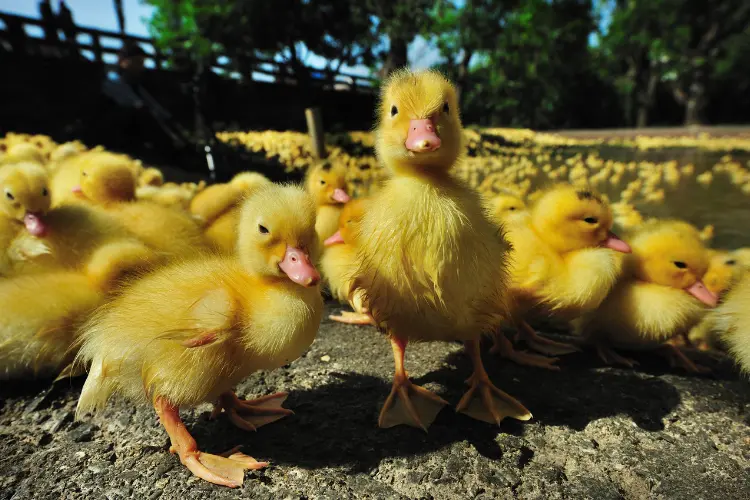
Adult Ducks
After the first few weeks, usually at 2-3 weeks old, you can transition your ducks from chicken layer feed to a “grower” feed, typically containing around 15-16% protein. Once your ducks reach around 20 weeks of age, you can switch them to a “layer” feed. Layer feeds contain around 16-18% protein and additional calcium necessary for egg production.
For meat ducks, a “finisher” feed with about 15% protein is used during the last few weeks before processing to promote weight gain.
Supplementary Feeding For Your Ducks
In addition to commercial feeds, ducks enjoy a variety of other foods. Fruits, vegetables, and leafy greens can be offered as nutritious treats! Ducks also love foraging for insects, worms, and slugs, making them excellent for natural pest control in your garden. It’s essential, however, to ensure these supplementary feeds don’t make up more than 10-15% of their diet.
Water for Ducks
Water plays a critical role in a duck’s diet. Ducks use water not just for hydration but also to keep their eyes, nostrils, and beaks clean. Provide your ducks with a water source deep enough for them to submerge their heads.
It’s important to note that baby ducks should always have access to water when eating. They need water to help them swallow their food, and a lack of water for tiny ducks during feeding can lead to choking.
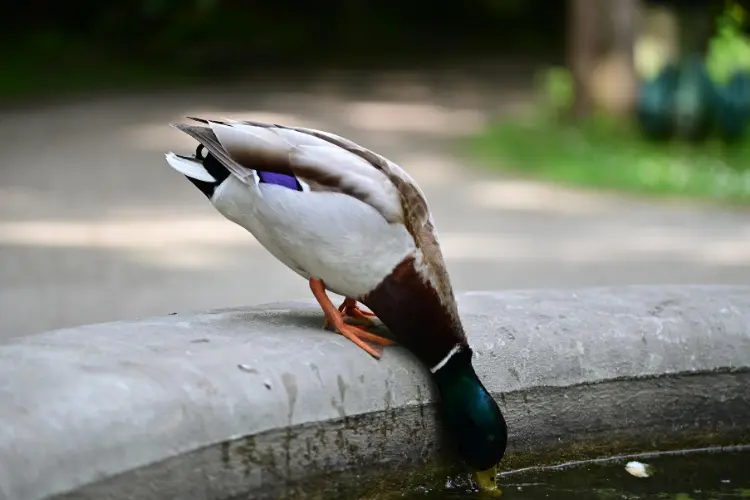
Foods That Can Be Dangerous For Ducks
Avoid feeding ducks bread, popcorn, and similar processed foods. These foods are low in nutritional value and can cause health issues. Also, avoid giving ducks anything salty, sugary, or caffeinated, and never offer moldy or rotten foods, as these can lead to severe health issues.
In conclusion, a well-balanced, nutritious diet is vital for your ducks’ health, growth, and productivity. Feed choices may differ based on the ducks’ age, purpose (meat or egg production), and availability of foods. Always ensure clean, fresh water is available for your ducks, and adjust their diet to maintain their overall health and happiness.
Like any other livestock, ducks are prone to certain diseases and health issues. Common problems include parasites, avian influenza, and botulism. Regular vet check-ups and vaccinations can help prevent these issues. Maintain cleanliness in their housing and change their water regularly to reduce disease risk.
Breeding Ducks
Breeding ducks can be a rewarding experience, allowing you to increase your duck flock in size, replenish your stock, and contribute to preserving specific duck breeds. Whether you’re a hobbyist looking to enjoy the process of hatching and raising ducklings or a farmer looking to have ducklings grow and boost your productivity, understanding the breeding habits of ducks is essential.
Ducks have distinct breeding patterns and habits. Most duck breeds begin laying eggs at around five to six months of age. The breeding season typically falls in spring when the days start getting longer, although some breeds, like the Khaki Campbell and Indian Runner, are known to lay eggs throughout the year.
It’s important to know that ducks do not need a drake (male duck) present to lay eggs. However, for the eggs to be fertilized and viable for hatching, a drake is required. Generally, the ratio of drakes to female ducks around should be about 1:5 to 1:7 to ensure efficient breeding without overtaxing the females.
Successful duck breeding requires an understanding of their nesting behaviors. Ducks prefer to lay eggs in a secure, quiet, and dark location. Providing nesting boxes filled with clean, dry straw or wood shavings can encourage this behavior.
Egg Laying
Once a duck begins to lay, she will typically lay one egg per day until she has a full clutch; usually about 8-15 eggs, depending on the breed. At this point, if she is broody and intends to hatch the eggs, she will start to sit on the nest most of the time, only leaving briefly to eat and drink.
The incubation period for duck eggs is about 28 days for most breeds, though Muscovy ducks take about 35 days. You’ll need to ensure the broody duck has access to food and water and is not disturbed during this critical period. If you are using an incubator, you’ll need to monitor the temperature and humidity carefully and turn the eggs regularly to ensure successful hatching.
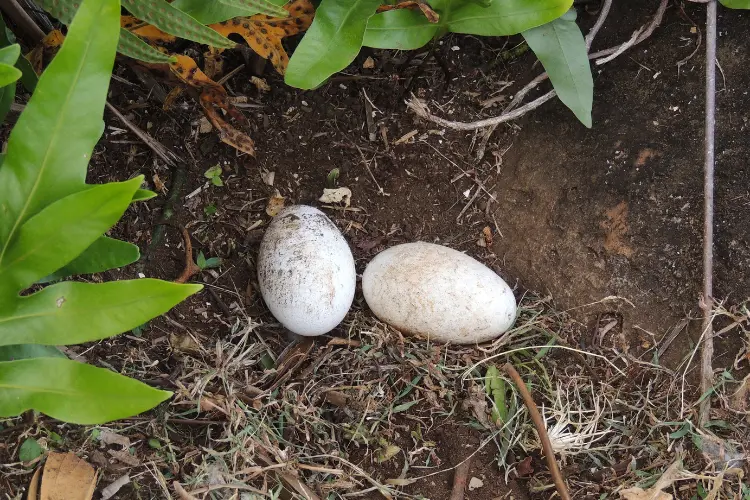
Keep in mind that not all duck breeds have strong broody tendencies. Breeds like the Pekin often lack the instinct to sit on and hatch their eggs, in which case you may need to use an incubator or a broody chicken hen to hatch the eggs. Once the ducklings hatch, they require proper care and a high-protein diet to support their rapid growth.
Above all, patience and careful observation of backyard flock are key to successful duck breeding. Every flock is unique, and gaining experience with your specific ducks will enhance your understanding and success over time!
Conclusion
Raising ducks is a unique and rewarding journey filled with both challenges and joys. Despite needing a good amount of care and attention, ducks offer numerous benefits, from eggs and meat to pest control and even companionship. Their distinctive personalities and habits make them charming additions to any backyard or farm. However, it’s essential to remember the commitment involved and ensure you can provide for their needs. Whether for their products or their delightful company, the adventure of duck keeping is truly worthwhile.

